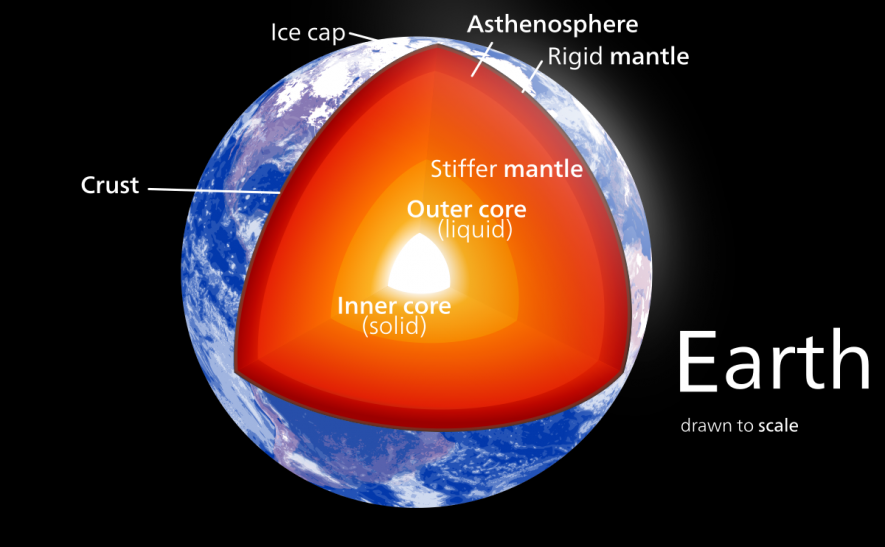Large Earthquakes Helped Scientists Understand the Inner Core of the Earth

Image source: Wikimedia commons, used for representation only.
Analysing the patterns of seismic waves emanating from large earthquakes, scientists claimed to have revealed the innermost core of the Earth. The scientists believe that they confirmed the existence of a distinctly different layer at the centremost part of Earth.
The study revealing these facts has been recently published in the journal Nature Communication. The study suggests that the innermost part of Earth consists of a hot solid ball of iron and nickel. The estimation suggests this core is around 800 miles or 1350 kilometres wide.
Any geology textbook displays a cutaway diagram to show how the inner parts of Earth are made up. The conventional diagrams show that Earth has four layers— the thin outer layer of rocks known as the crust and this is the layer that we live on; the mantle, which consists of rocks; the outer core, which is made up of iron and nickel and where Earth's magnetic field is generated; the last is the solid inner core. The new study reveals that there exists another distinct inner layer.
Commenting on the study results, Hrvoje Tkalcić, a co-author of the study and a professor of geophysics at Australian National University, said in a statement, "We have now confirmed the existence of the innermost inner core."
Notably, the distance to the Earth's centre is approximately 4000 miles, and no one can drill down more than a few miles into the crust. So, revealing what is deep beneath the Earth's crust depends only on studying the seismic waves. Earth's inner core, as we now know, is around 1500 miles or 2440 kilometres wide and was discovered way back in 1936. Even at that time, scientists relied upon seismic waves for this discovery.
The concept of the innermost part of the inner core was first proposed in 2002 by seismologists from Harvard University— Miaki Ishii and Adam Dziewonski.
In their research paper published in PNAS that year, they came to the proposal based on the peculiar patterns of the speed of seismic waves that travel through the inner core. The researchers found a difference in the speed of the seismic waves when they travel in different directions.
When the waves travel from pole to pole, along the axis of the Earth, they are the fastest, and they travel at the slowest speed in the direction perpendicular to the axis of the Earth. Geophysicists believed that this difference in speed, depending on the direction, arises out of the alignment of crystals of iron in the inner core.
The 2002 paper also said that at a smaller region at the centre, the waves that travel at 45 degrees to the axis were the slowest, not at the 90-degree angle (of a perpendicular movement). At that time, the data was inadequate to establish the idea. Now, the increasing sophistication of seismic monitoring techniques has enabled scientists to say it with more clarity.
Commenting on the research procedures, the corresponding author of the latest study, Thanh-Son Pham, said, "We analysed digital records of ground motion, known as seismograms, from large earthquakes in the last decade. Our study becomes possible thanks to the unprecedented expansion of the global seismic networks, particularly the dense networks in the contiguous US, the Alaskan peninsula and over the European Alps."
"I like to think about the inner core as a planet within the planet. Indeed, it is a solid ball, approximately the size of Pluto and a bit smaller than the moon. If we were somehow able to dismantle the Earth by removing its mantle and the liquid outer core, the inner core would appear shining like a star. Its temperature is estimated to be about 5,500-6,000 degrees (Celsius/9,930-10,830 Fahrenheit), similar to the sun's surface temperature," commented Hrvoje Tkalcić in a statement to Reuters.
The newly confirmed innermost sphere of the inner core is hot enough to exist in a molten state, but scientists say that it rather exists in a solid state as an alloy of iron and nickel because of the extreme pressure at the centre of the Earth.
Get the latest reports & analysis with people's perspective on Protests, movements & deep analytical videos, discussions of the current affairs in your Telegram app. Subscribe to NewsClick's Telegram channel & get Real-Time updates on stories, as they get published on our website.
















